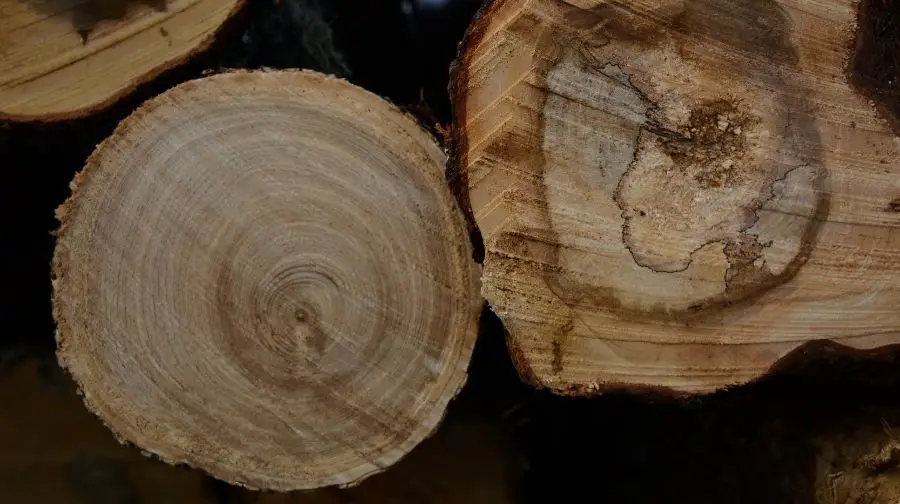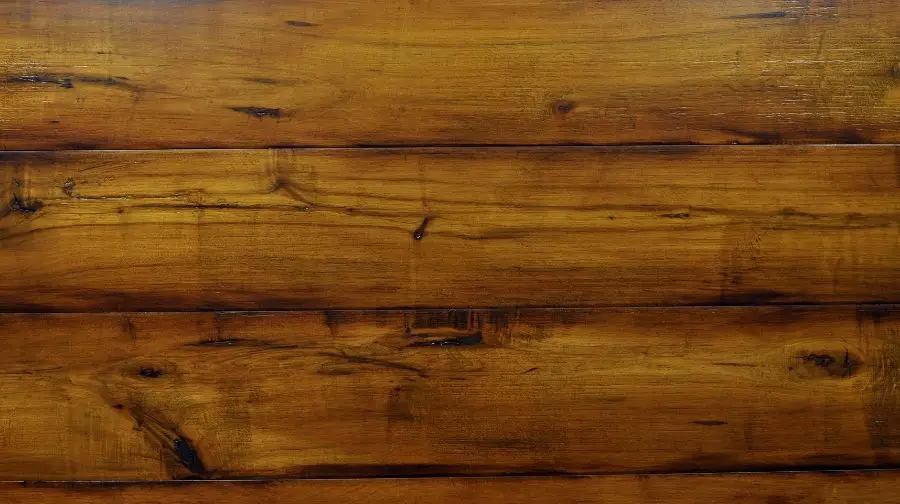
Maple wood, as the name indicates, is cut from maple trees. These trees are are abundant and can grow very large. That’s why they have been widely used for DIY and carpentry projects.
Furthermore, maple wood has beautiful grain, which makes it useful in various projects, besides making it relatively expensive because of the unique and attractive look. Some of it’s wood grain has a flame-like appearance, while others may have small knots. These knots are also known as bird’s eye maple trees.
Some cuts have been widely used in products such as cellos, double basses, violas, violins, and more. That’s why they are often called fiddleback maple. However, maple can be susceptible to shrinkage every time there’s fluctuation in humidity. Still, this doesn’t lower its uses.
When it comes to using a maple wood color stain, you have to sand the wood thoroughly and relatively more than any other wood to get an even finish while preventing blotches. This stain is comparatively fast drying and can be either oil or water-based stain that penetrates deeply into the wood to get the desired finish for a long time.
Table of Contents
Does Maple Wood Stain Well?
Maple is one of the notoriously difficult woods to stain besides pine, cherry, and birch. Its ability to absorb the pigments more than usual can be challenging.
However, maple has an attractive grain pattern, but it always ends up with dark blotchy areas once you apply the stain. The best way to stain the maple wood well is first to sand the wood as many times as you can then seal the wood with a pre-stain wood conditioner. Or you can later eliminate the dark areas by staining with a lighter color. Also, go for pigments that don’t soak deep into the wood to end up with the look you need.
What Is The Best Finish for Maple?
If you’re looking to get the best clear finish on curly maple, it can be done using Howard Products RF2016. You also can try tung oil or linseed oil to pop the grain after final sanding. Also you can use dye for bold and stunning figure pop using aniline dye.
Discover 1,000 Hours Of Step-By-Step Woodworking Videos

It’s called Woodwork101. A database of detailed videos and blueprints in crystal clear, mouth-watering HD that will take you by the hand and show you that DIY home projects done the right way are easy, fun, and always of top quality… turning a dream into reality in a heartbeat. Getting you that perfect build each and every time.
Testing Stains on Maple Wood
Subscribe to Dave the Woodworker on Youtube
Does Maple Need to be Conditioned Before Staining?
Pre-stain wood conditioner can be a great way to prevent blotchiness when staining Maple because it prepares the surface for perfect staining. The purpose is to fill in the soft porous wood pores leaving you an even surface to stain avoiding uneven absorption that leads to blotches on the wood.
However, if you use water-based stains or gel stains instead of liquid-oil-based stains, you may not need pre-conditioning the maple wood to get the perfect stain.
What Is The Best Way to Stain Maple Wood?
The best way to stain maple wood is first sand it as much as you can because this wood is famous for leaving dark blotchy areas. Then try using water-based or gel oil-based stains. If you still end up having dark areas, try staining the lighter color to dark areas to get the even stain.
Here’s a step-by-step guide to perfectly stain maple wood:
- Step 1: Get 120-grit sand to smooth the surface out, so you can have the surface prepared for staining. Focus on rough areas and make them as smooth as you can to avoid blotchy areas.
- Step 2: Use a 220-grit to make the sanding further precise for perfect results.
- Step 3: Wipe the dust off the wood and use a wet cloth to perfectly remove the debris off the wood, so you can make it ready for staining.
- Step 4: Apply pre-stain wood conditioner to let the wood absorb the stain to get an even color. Give it a 10 to 15 minute period before you go to the next step.
- Step 5: Stain the wood using a bristle brush or rag, and make sure you rub evenly on the entire wood surface.
- Step 6: Wait for a particular period and let the stain dry naturally. Once it gets dry, use a damp cloth to further dry the stain, which will be absorbed by the cloth.
- Step 7: Give at least four hours to settle the stain deep into the wood pores, so there’s no dark area on the wood.
- Step 8: If you want to make the surface darker, apply another coat of the same stain. Apply as many times as you want to get the color more dark.
- Step 9: Apply the protective coat to make the staining further solid that also avoids ruining before a prolonged time.
How To Prepare And Stain Maple Wood Like A Boss
Subscribe to Rizzi Painting on Youtube
Does Gel Stain Work Well on Maple?
Gel stains are highly recommended for porous woods like cherry, maple, pine, and birch that often cause blotchy spots. Since gel stains are not liquid-oil-based, they can’t be a problem in terms of blotch. It’s the best alternative for liquid-oil stains to get perfect results without dealing with dark areas.
[Video] 3 Most Common Mistakes
When Setting Up Shop

A woodworking friend of mine shared this video by Ralph Chapman with me that helped him set up his workshop.
The video explains the benefits of Ralph Chapman’s guide about setting up an affordable workshop and avoiding the most common mistakes offers to anyone interested in woodworking.
Best Maple Wood Stain
Most people struggle to find the best maple stain. That’s why we came up with some of the best maple wood stains, so you can end up having perfect colors on your maple wood.
Howard Products RF2016 features a restor-a-finish formula that penetrated deep into the maple wood while blending out minor scratches, abrasions, and blemishes. Besides maple, the stain is the best match for dark walnut, dark oak, golden oak, maple pine, walnut, cherry, and more woods.
Minwax Wood Gel Stain is another exceptional stain that provides the best finish. Since it’s highly recommended to get gel stain instead of liquid oil-based stain, this one can be a great choice. The stain offers even colors while avoiding darker areas.
Minwax Wood Finish is a convenient product to get a brilliant finish, especially on maple wood of any kind. It gives you a fast and easy way to finish the maple woods. However, you may need to go through the sanding and wiping process before you apply this stain to get stunning results.

Maple Stain on Pine
Pine is known for absorbing more stain than normal, which can make it more difficult to stain. In that case, you have to overcome this factor to get a perfect maple stain on pine. You have to give the pine a texture of maple first. It can be done through sealing techniques that seal the pores into the wood, so no more stain is absorbed than normal.
To do so, you can rub the pine wood surface with a light coat of one-step light golden color stain with a clean, soft cloth. Once you do that, you can have a sealed surface as maple wood to get maple wood stain started. However, orange and blue colors can be the best choice in staining the pine wood.
How to Achieve Dark Even Finishes on Maple With Water Based Stain
Subscribe to General Finishes on Youtube
Colonial Maple Wood Stain
Colonial is one of the most modest earth tone colors, including reddish-brown, dark brown, creamy yellow, white, almond, ochre, muted green, taupe, and beige. Their source is natural and can be soil, minerals, and plants. When it comes to colonial maple wood stain, it can be a great choice for outdoor staining while giving brilliant color on different styled woods, including decks, railings, and doors.
Does Maple Wood Stain Get Blotchy?
Every time someone talks about maple wood, the first thing in mind that pops up is blotchy spots. No matter how experienced you are in dealing with the blotchiness, maple can still come out blotchy if your aren’t careful. The main causes are either poorly sanding or it can the wood itself, which is extremely hard and may not let the stain deeply penetrate into it. As a result, you got blotchy wood.
In that case, there’s more than one thing that you can try to fix blotchy maple stains. First, try sanding again and again until you get the smooth surface ready to absorb the stain particles deep into the woods. Second, stripping and sanding at the same time. You can try applying a wash coat of shellac that also works when applied before staining maple wood.
Furthermore, another helpful technique in fixing the blotchy spots is using a glaze to soften the contrast between the lighter and deeply colored areas. This way, you may end up having the same color all over the maple wood without having it blotchy to ruin the staining. Try all these methods one by one.





